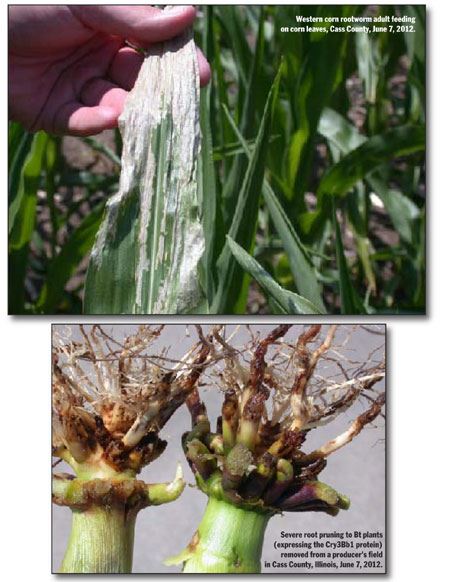Injury To Bt Corn Observed: Western Corn Rootworm Adults Have Emerged
URBANA, ILL.
The western corn rootworm
“season” is underway
at a pace earlier than
I have experienced since I
began studying this versatile
insect as a graduate student
in the late 1970s. In response
to a request by a seed industry
representative, I traveled
to western Cass County on June 7 to verify a report
of severe injury to Bt corn that expresses
the Cry3Bb1 protein targeted against corn rootworms.
Last year I observed severe root injury to some
producers’ fields in northwestern Illinois (Henry
and Whiteside counties; and north-central Illinois
(La Salle County; that had been planted to
Bt hybrids expressing the Cry3Bb1 protein. In
2011, similar reports of injury to Bt hybrids expressing
this protein surfaced in some other
north-central states, most notably Iowa, where
Dr. Aaron Gassmann, an Iowa State entomologist,
published a journal article confirming the
development of resistance to the Cry3Bb1 protein
in some areas of the state by western corn
rootworms. Thus far, we have not confirmed resistance
to this protein in Illinois. We are cooperating
with Dr. Gassmann’s laboratory to
determine if the Illinois fields in 2011 were infested
with a resistant population. Results
should be forthcoming in August of this year.
In light of the problems that began to surface
last season in Illinois and some other midwestern
states, the report concerning performance
issues with a Bt hybrid in Cass County warranted
attention. On arriving at the first field, I
was amazed at the number of western corn rootworm
adults in the whorls of plants. The seed
industry representatives indicated that beetles
had been observed earlier in the week.
This is the earliest that I have observed adult
western corn rootworms, nearly one full month
ahead of when I typically begin to receive reports
– around the 4th of July. The plants were
under intense moisture stress, and the leaves
were tightly rolled. In addition, beetles were
feeding on the epidermis of corn leaves. This
type of injury often occurs when beetle emergence
is early and plants have not yet begun to
shed pollen or produce silks. The plants in the
fields that I visited were not at this reproductive
stage of development, even though planting had
occurred between March 30 and April 2.

After removing roots randomly from the first
field, we traveled to a nearby field that also had
been planted to a Bt hybrid expressing the
Cry3Bb1 protein. Not as many beetles were seen
in the second field. Again, we removed roots at
random for inspection. Roots from both fields
exhibited feeding injury, but the second field
had much more injury. Because adults were not
as noticeable in the second field, and emergence
was just beginning in the first field, I believe
more root feeding will continue in both places.
Because the plants were short and the soil was
hard and dry, there was no lodging. However,
as root feeding continues and plants become
taller, lodging should be expected, especially if
storms with rain and winds materialize.
On June 8, plants that had been dug and evaluated
for root injury were checked for the expression
of the Cry3Bb1 protein at our
University of Illinois laboratory. All plants tested
positive for the Cry3Bb1 protein. This does not
mean that a resistant western corn rootworm
population has been confirmed in Illinois. The
registrant of this technology has been notified
and will conduct some follow-up investigations
in these fields. So, at this point, precise reasons
for the continuing performance challenges of
some Bt hybrids expressing this protein remain
elusive. However, producers should remain vigilant
and report any performance issues that
surface with their Bt hybrids regarding corn
rootworm injury this growing season.
Similar to the affected fields with Bt performance
issues last year, the fields in Cass County
had been in continuous corn for many years (at
least 10 consecutive years). In addition, the
same trait (Cry3Bb1) had been used since 2007
(6 growing seasons). Under these conditions,
the selection pressure for resistance development
is markedly increased. It remains to be
seen how the rest of this growing season will
play out. For now, it makes sense to monitor
this unfolding situation carefully and to pay attention
to the performance of your chosen Bt
hybrid this season. Longer term, it will be increasingly
important to integrate management
practices such as rotating corn with other
crops, rotating Bt traits from season to season,
considering the use of a non-Bt hybrid along
with a soil insecticide at planting, and not neglecting
the use of a refuge if a Bt hybrid is
planted. Δ
DR. MICHAEL GRAY: Professor/Crop Sciences
Extension Coordinator & Assistant Dean for ANR
Extension Programs, University of Illinois